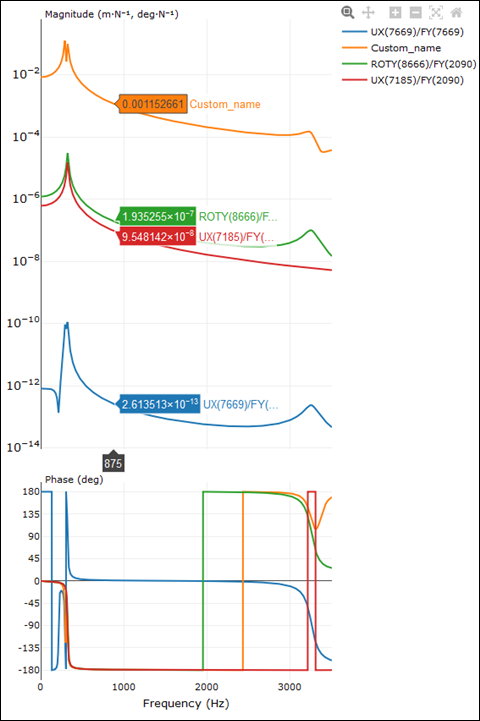The FRF Plotter displays the FRF graphs of all the selected DOF pairs (rows) in the second table in the FRF Worksheet. It is displayed when a completely defined DOF pair is selected in a solved FRF Calculator object.
The FRF Plotter is divided into two parts:
- FRF Plot
A dynamic plot that allows hovering, zooming and panning operations. Depending on the Plot Type, the complex plot can be shown in Magnitude/Phase or in Real/Imaginary graphs. The maximum and minimum frequency values on the x-axis are restricted to those defined in the FRF Calculator Details. The entire data range can be plotted by clicking the option. Clicking the icon (reset axes) replots the data in the user-defined frequency range.

- FRF Options
The following properties are available:
Physics
Allows you to change the Physics of the FRF calculation (, , , or according to the FRF Calculation Method). You can click the button to reverse the physics and instead calculate (F/X), (F/V) or (F/A). Reverse Physics will skip 0 values of the direct FRF.
If you select ERP or ERPL, you will only see FRFs calculated according to the FRFs that have been generated with output elements in the FRF Worksheet. Otherwise, you will see FRFs that have been generated with one single output node.
Plot Type
Allows you to toggle between the and displays in the FRF Plot. For ERP and ERPL only the magnitude is available, and this option is hidden.

An export is triggered by clicking the buttons to the right of the Details view.
The file format for export can be CSV (Export to CSV file button), UNV (Export to UNV file button, only if the Physics is not reversed), or h5 (Export to h5 file button). For ERP and ERPL, only the CSV option is available.
For CSV files, the FRFs are exported using the same format in which they are plotted (Magnitude/Phase or Real/Imaginary), and with the same Physics.
For UNV files, the FRFs are exported in Real/Imaginary format and with Compliance (X/F) Physics.
For h5 files, the FRFs are exported in Real/Imaginary format as DPF Fields Containers and with Compliance (X/F) Physics. This will be an input for Fast-NVH.


